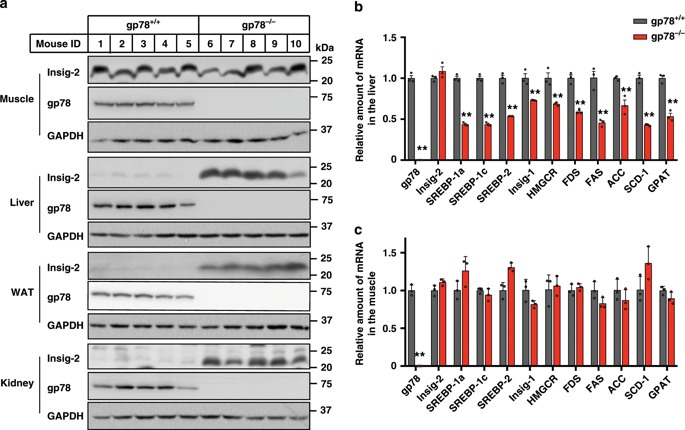当前位置:
X-MOL 学术
›
Nat. Commun.
›
论文详情
Our official English website, www.x-mol.net, welcomes your
feedback! (Note: you will need to create a separate account there.)
Competitive oxidation and ubiquitylation on the evolutionarily conserved cysteine confer tissue-specific stabilization of Insig-2.
Nature Communications ( IF 14.7 ) Pub Date : 2020-01-17 , DOI: 10.1038/s41467-019-14231-w Zhang-Sen Zhou 1 , Mei-Xin Li 1 , Jie Liu 1 , Hengwu Jiao 1 , Jing-Ming Xia 1 , Xiong-Jie Shi 1 , Huabin Zhao 1 , Liping Chu 2 , Jingrong Liu 2 , Wei Qi 2 , Jie Luo 1 , Bao-Liang Song 1
Nature Communications ( IF 14.7 ) Pub Date : 2020-01-17 , DOI: 10.1038/s41467-019-14231-w Zhang-Sen Zhou 1 , Mei-Xin Li 1 , Jie Liu 1 , Hengwu Jiao 1 , Jing-Ming Xia 1 , Xiong-Jie Shi 1 , Huabin Zhao 1 , Liping Chu 2 , Jingrong Liu 2 , Wei Qi 2 , Jie Luo 1 , Bao-Liang Song 1
Affiliation

|
Insig-2 is an ER membrane protein negatively controlling lipid biosynthesis. Here, we find that Insig-2 is increased in the tissues, including liver, but unaltered in the muscle of gp78-deficient mice. In hepatocytes and undifferentiated C2C12 myoblasts, Insig-2 is ubiquitylated on Cys215 by gp78 and degraded. However, the C215 residue is oxidized by elevated reactive oxygen species (ROS) during C2C12 myoblasts differentiating into myotubes, preventing Insig-2 from ubiquitylation and degradation. The stabilized Insig-2 downregulates lipogenesis through inhibiting the SREBP pathway, helping to channel the carbon flux to ATP generation and protecting myotubes from lipid over-accumulation. Evolutionary analysis shows that the YECK (in which C represents Cys215 in human Insig-2) tetrapeptide sequence in Insig-2 is highly conserved in amniotes but not in aquatic amphibians and fishes, suggesting it may have been shaped by differential selection. Together, this study suggests that competitive oxidation-ubiquitylation on Cys215 of Insig-2 senses ROS and prevents muscle cells from lipid accumulation.
中文翻译:

进化上保守的半胱氨酸的竞争性氧化和泛素化赋予 Insig-2 的组织特异性稳定性。
Insig-2 是一种内质网膜蛋白,负向控制脂质生物合成。在这里,我们发现 Insig-2 在包括肝脏在内的组织中增加,但在 gp78 缺陷小鼠的肌肉中没有改变。在肝细胞和未分化的 C2C12 成肌细胞中,Insig-2 在 Cys215 上被 gp78 泛素化并被降解。然而,在 C2C12 成肌细胞分化为肌管期间,C215 残基会被升高的活性氧 (ROS) 氧化,从而阻止 Insig-2 泛素化和降解。稳定的 Insig-2 通过抑制 SREBP 途径下调脂肪生成,有助于将碳通量引导至 ATP 生成并保护肌管免受脂质过度积累。进化分析表明,Insig-2 中的 YECK(其中 C 代表人类 Insig-2 中的 Cys215)四肽序列在羊膜动物中高度保守,但在水生两栖动物和鱼类中则不然,这表明它可能是通过差异选择形成的。总之,这项研究表明 Insig-2 Cys215 上的竞争性氧化泛素化可感知 ROS 并防止肌肉细胞脂质积累。
更新日期:2020-01-17
中文翻译:

进化上保守的半胱氨酸的竞争性氧化和泛素化赋予 Insig-2 的组织特异性稳定性。
Insig-2 是一种内质网膜蛋白,负向控制脂质生物合成。在这里,我们发现 Insig-2 在包括肝脏在内的组织中增加,但在 gp78 缺陷小鼠的肌肉中没有改变。在肝细胞和未分化的 C2C12 成肌细胞中,Insig-2 在 Cys215 上被 gp78 泛素化并被降解。然而,在 C2C12 成肌细胞分化为肌管期间,C215 残基会被升高的活性氧 (ROS) 氧化,从而阻止 Insig-2 泛素化和降解。稳定的 Insig-2 通过抑制 SREBP 途径下调脂肪生成,有助于将碳通量引导至 ATP 生成并保护肌管免受脂质过度积累。进化分析表明,Insig-2 中的 YECK(其中 C 代表人类 Insig-2 中的 Cys215)四肽序列在羊膜动物中高度保守,但在水生两栖动物和鱼类中则不然,这表明它可能是通过差异选择形成的。总之,这项研究表明 Insig-2 Cys215 上的竞争性氧化泛素化可感知 ROS 并防止肌肉细胞脂质积累。











































 京公网安备 11010802027423号
京公网安备 11010802027423号